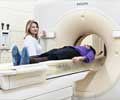
The diagnosis of abuse relies heavily on the presence of skeletal injuries, and high-quality skeletal surveys (a series of X-rays of all the bones in the body) are recommended to visualize the often subtle high-specificity fractures seen in infant abuse. Bruises are the most common sign of physical abuse, but subcutaneous tissue and muscle injuries are not currently evaluated with a global imaging technique in living children.
The study, performed at Children's Hospital Boston and Harvard Medical School in Boston, MA, included 21 infants who underwent whole-body MRI for the evaluation of suspected child abuse. Summary skeletal survey and whole-body MRI identified 167 fractures or areas of skeletal signal abnormality. "Although our study results revealed that whole-body MRI is insensitive in the detection of classic metaphyseal lesions and rib fractures, we found it did identify soft-tissue injuries such as muscle edema and joint effusions that, in some cases, led to identifying additional fractures," said Jeannette M. Perez-Rossello, MD, lead author of the study.
"Although our study indicates that whole-body MRI is currently unsuitable as a primary global skeletal imaging tool for suspected imaging abuse, it may be useful as a supplement to the skeletal survey in selected cases, particularly with regard to soft tissue injuries," said Perez-Rossello.
Source-Eurekalert










